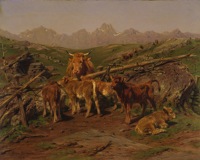Wean
Origin
Middle English wenen, from Old English wenian to accustom, wean; akin to Old English wunian to be used to
Definitions
- 1: to accustom (as a young child or animal) to take food otherwise than by nursing
- 2: to detach from a source of dependence <being weaned off the medication> <wean the bears from human food — Sports Illus.>; also : to free from a usually unwholesome habit or interest <wean him off his excessive drinking> <settling his soldiers on the land… , weaning them from habits of violence — Geoffrey Carnall>
- 3: to accustom to something from an early age —used in the passive especially with on <students weaned on the Internet for research> <was weaned on greasepaint — Helen Hayes> <the principles upon which he had been weaned — J. A. Michener>
Description
Weaning is the process of gradually introducing a mammal infant, either human or animal, to what will be its adult diet and withdrawing the supply of its mother's milk.
The process takes place only in mammals, as only mammals produce milk. The infant is considered to be fully weaned once it no longer receives any breast milk (or bottled substitute).
Weaning in human infants
Solid food is gradually introduced to a baby's diet, alongside its previous diet of breast or formula milk, at around six months (though this varies slightly from child to child). Before this, a child's digestive system and kidneys are still developing and are not yet ready to deal with solid food.
Soft, runny food such as mashed fruit or vegetables are introduced to babies in the early stages of weaning, as they do not have teeth and are unable to chew. Certain foods are recommended to be avoided, such as those containing nuts or high levels of gluten, salt, or sugar. Foods harbouring bacteria that a young digestive tract could not deal with, such as containing nuts, honey, eggs and shellfish, should also be avoided.
Weaning conflict
Weaning conflict occurs when the mother wishes to stop nursing but the infant wishes to continue. At this point, the mother tries to force the infant to cease nursing, while the infant attempts to coerce the mother to continue. From an evolutionary perspective, weaning conflict may be considered the result of the cost of continued nursing to the mother, perhaps in terms of reduced ability to raise future offspring, exceeding the benefits to the mother in terms of increased survival of the current infant. This can come about because future offspring will be equally related to the mother as the current infant, but will share less than 100% of the current infant's genes. So, from the perspective of the mother's evolutionary fitness, it makes sense for her to cease nursing the current infant as soon as the cost to future offspring exceeds the benefit to the current infant. But, assuming the current infant shares 50% of the future offsprings' genes, from the perspective of the infant's own evolutionary fitness, it makes sense for the infant to continue nursing until the cost to future offspring exceeds twice the benefit to itself. Weaning conflict has been studied for a variety of mammal species, including primates and canines.
Weaning in other mammals
In science, a lot of mice are used in laboratory experiments. When breeding laboratory mice in a controlled environment, the weaning is defined as the moment when the pups are transferred out of the mothers' cage. Weaning is recommended at 3 to 4 weeks after parturition.
References
- Solids: the first steps. Retrieved 2010-06-28.
- Salmon, C. & Shackelford, T.K. (2008). Family Relationships: An Evolutionary Perspective. Oxford University Press. pp. 148–149. ISBN 9780195320510.
- "Parent-offspring conflict". Retrieved 2009-09-23.
- Trivers, R. (2002). Natural selection and social theory. Oxford University Press. pp. 124–126. ISBN 9780195130621.
- "Gorilla". National Primate Research Center, University of Wisconsin - Madison. Retrieved 2009-09-23.
- Packard, J.M., Mech, L.D. & Ream, R.R.. "Weaning in an arctic wolf pack:behavior mechanisms". pp. 1269–1275. Retrieved 2009-09-23.
- https://ko.cwru.edu/services/musfrming.html
